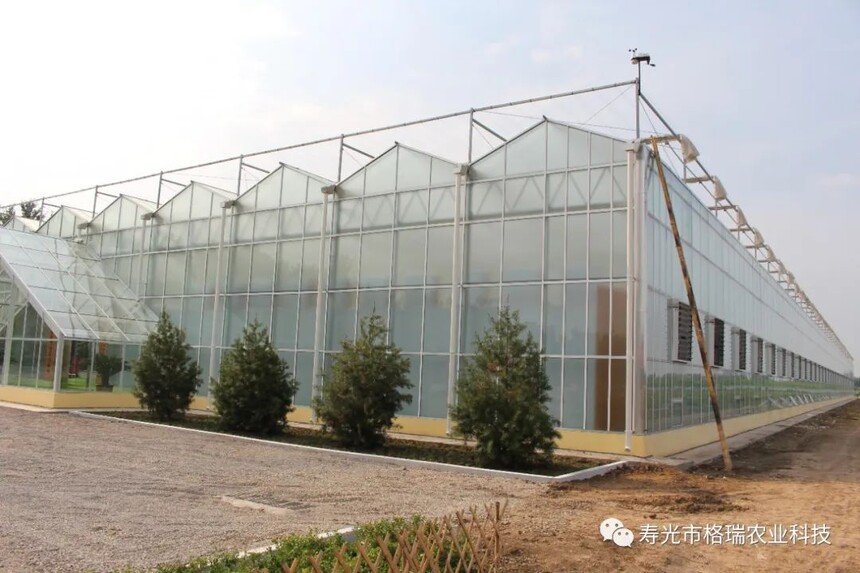|
Technical regulations for construction of high-efficiency solar greenhouse and vegetable plantingFirst, build a reasonable solar greenhouse Site selection 1. The venue is open and sunny. The construction of efficient solar greenhouse must be selected in the east, south and west three directions without shade, can see the sun early in the morning, the daytime sunshine is long, and the indoor can get more sufficient light. 2, flat terrain, fertile soil. The site should be flat, and the slope to the south is more favorable, the slope should not be greater than 10 degrees, the groundwater level should not be too high, the soil should choose deep soil, fertile soil, sandy soil rich in organic matter is appropriate. 3, sufficient water, with power supply equipment. Greenhouse water is best to use groundwater, water supply through the pipeline, the water quality is good, the salt content can not exceed the degree of tolerance of crops, so as to avoid salt damage. Greenhouse seedlings, drip irrigation and night management all require electricity, so power supply equipment is indispensable.
Second, arrange the cultivation season reasonably The principle of planting crops and stubble arrangement in solar greenhouse should first consider that the temperature and light conditions created by the solar greenhouse can meet the growth requirements of some crops in specific production seasons; Secondly, producers have a basic understanding and mastery of relevant production technology; The third is conducive to crop rotation and pest control, under normal circumstances should master the following principles: 1. Arrange crop stubble according to the greenhouse structure. Different configurations of solar greenhouses, with different temperature and light performance, for the second generation of solar greenhouses, if the construction can be strictly in accordance with the requirements of the construction, the indoor temperature can not be lower than 8 ° C, winter and spring stubble-like warm vegetables, such as cucumbers, zucchini, tomatoes, etc. 2. Arrange crop stubble according to market demand. The production of fresh vegetables is a highly commercial industry, and its benefit depends on the market demand. Therefore, when arranging the stubble, the peak period of results should be arranged in the season of high prices and good benefits. 3, to be conducive to rotation and stubble, for vegetables that avoid continuous cropping, more attention needs to be paid to the arrangement of stubble. Third, choose the appropriate variety Suitable and excellent varieties are the basis of efficient cultivation. In addition to the general selection of low-temperature, low-light, high-temperature, early-maturing and disease-resistant varieties, greenhouse cultivation also needs to select the corresponding special varieties according to the different requirements of different cultivation seasons. 1, suitable for summer cultivation of crop varieties, generally required to have early maturity, strong growth potential, high temperature resistance, disease resistance and other characteristics. 2. Crop varieties suitable for cultivation after autumn delay are required to have the characteristics of high temperature resistance in the early stage, low temperature resistance in the late stage, strong photosynthetic capacity, disease resistance, and good yield performance. 3, winter stubble, early spring crop cultivation, require strong winter, low temperature resistance, low light, high humidity and disease resistance, high yield, high quality and other characteristics.
Fourth, flexibly adjust the greenhouse environment 1, temperature control Solar greenhouse temperature control, not only according to different crop types, different varieties, different growth stages of the temperature requirements of the adjustment and control, and because the light is a key factor in the production of solar greenhouse, it should also be in accordance with the change of light, temperature management should be adjusted accordingly. ① Thermal insulation management. In the production process, we should flexibly control the covering time of the curtain according to the temperature in the greenhouse. ② Temperature management. In terms of management, it is necessary to wipe the dust outside the film often, keep the film surface clean, and increase the amount of light; Hang a reflective screen on the back wall of the greenhouse; In addition, the back wall can also be painted black to save heat and increase the temperature in the greenhouse. ③ Cooling management. High temperature weather often occurs in spring, should be timely ventilation and cooling. In the production, we mainly reduce the indoor temperature by natural ventilation and convection heat dissipation, and the ventilation and cooling are mostly carried out at noon on sunny days. 2, humidity control In the relatively high humidity environment, it is easy to induce diseases, cucumber downy mildew, powdery mildew, wilt, tomato blight and gray mold are easy to occur. Therefore, in order to prevent disease and obtain high quality and high yield, it is very necessary to regulate humidity according to crop growth needs. ① Ventilation. In the cold season, it is necessary to ensure that crops do not suffer from freezing damage under the premise of ventilation and humidity reduction. ② Appropriate control of water flow. Evaporation and water flow can be effectively reduced by drip irrigation and high furrow irrigation combined with film mulching. ③ Cover the cardigans with grass. The walkway between the cardigans for people to work, and the role of mulching film after covering grass.
Fifth, reasonable plant adjustment 1. Pruning. Through pruning, the growth of vegetative organs and fruits can be balanced, the individual size can be enlarged, the quality can be improved, and the ventilation and light transmittance of plants can be improved. 2. Bifurcation. The purpose of pruning is to reduce nutrient consumption, promote fruit development, facilitate close planting, and obtain higher yield. 3, thin flowers, fruit, beat leaves. In addition to the normal growth of the fruit, the rest of the flowers and fruits should be removed. The thinning of flowers and fruits should be carried out in time to avoid the consumption of nutrients, and the old leaves and diseased leaves in the lower part should be knocked off in time to facilitate ventilation and reduce disease. |






